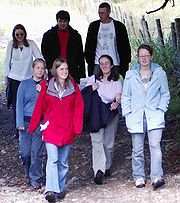
Castlerigg Manor
Encyclopedia

Catholic
The word catholic comes from the Greek phrase , meaning "on the whole," "according to the whole" or "in general", and is a combination of the Greek words meaning "about" and meaning "whole"...
Residential Youth Centre - also often referred to as Catholic Youth Retreat Centres
Catholic Residential Youth Work
Catholic residential youth work is the work of the youth retreat centres and residential centres operated by the Catholic Church. In the UK, Catholic residential youth work is an important part of the Church's ministry to young people.-History:...
- in Keswick
Keswick, Cumbria
Keswick is a market town and civil parish within the Borough of Allerdale in Cumbria, England. It had a population of 4,984, according to the 2001 census, and is situated just north of Derwent Water, and a short distance from Bassenthwaite Lake, both in the Lake District National Park...
, Cumbria, in the north of England's Lake District
Lake District
The Lake District, also commonly known as The Lakes or Lakeland, is a mountainous region in North West England. A popular holiday destination, it is famous not only for its lakes and its mountains but also for its associations with the early 19th century poetry and writings of William Wordsworth...
National Park. The centre is owned and operated by the Catholic Diocese
Diocese
A diocese is the district or see under the supervision of a bishop. It is divided into parishes.An archdiocese is more significant than a diocese. An archdiocese is presided over by an archbishop whose see may have or had importance due to size or historical significance...
of Lancaster, although it serves Catholic organisations from much of northern England and beyond.
The ministry of Castlerigg Manor is to run residential retreats/ courses for groups of Catholic young people. These groups come mainly from Catholic schools in the Lancaster, Salford, Liverpool & Shrewsbury Diocees, although occasionally from Catholic parishes as well, including Confirmation groups, youth groups and groups of altar servers. Current estimates suggest that since its establishment in 1969, Castlerigg Manor has worked with over 100,000 young people. The current demand placed upon Castlerigg Manor reflects the growing success of Catholic Youth Work
Catholic Youth Work
The phrase Catholic youth work covers a wide range of activities carried out with young people, usually in the name of the Catholic Church and with the intention of imparting the Catholic faith to them and inviting them to practice and live out the faith in their lives...
projects.
History
Best estimates suggest that the building of Castlerigg Manor has existed since the late 1840s. It was originally a Manor House from which much of the land around it was owned and administered. It became a hotel in the 1920s. It was used briefly during the Second World War by the Army as a base for teaching soldiers the skills of driving in mountainous terrain.In 1969 Monsignor Patrick O'Dea acquired the building on behalf of the Diocese of Lancaster together with the gate house which is now used as a holiday cottage. The Diocese had been involved in residential youth work in the 1960s at Lakeside House; a smaller premises in Keswick, which was fast becoming too small for the demand placed upon it.
Work & Mission - An Article
The following is taken from an article that was written by Jack Regan, the former Team Leader/ Programme Co-ordinator, in June 2004 and was published in the Catholic Voice; the newspaper of Lancaster Diocese:
Most of the UK’s twelve Catholic retreat centres came about in the immediate post-Vatican II period; a time which saw a real revival in youth ministry in the light of the council’s reflections on how the faith is applicable to the modern world. It was into this new exploration that Castlerigg Manor was born as a residential youth centre in 1969 The years since have seen an estimated 90,000 young people and teachers pass through the centre and a great many people, from Lancaster Diocese and beyond, devote a couple of years of their lives to its work. It is always nice to meet people who came to Castlerigg many years ago who still hold happy memories of the place and the current demand placed on us, though depriving us of much-needed sleep, is extremely welcome.
For the uninitiated, allow me to explain that Castlerigg Manor runs courses for groups of school pupils and, somewhat less frequently, parish groups as well. The difference between us and many of the other Catholic residential youth centres around the country though is that we are not strictly a retreat centre. Although the word is often used, the work of Castlerigg encompasses many aims. We are partly a retreat centre, but the courses we run also have a slant on many other issues, such as interpersonal skills, social issues, justice and peace and others. All of the issues we address are set very clearly in the context of the Christian mission and the response that we as Christian individuals should give to Christ’s calling in our daily lives. This mixture of the reflective, the evangelical and the practical is proving very popular, a fact to which our increasing waiting list and the uptake for our open retreats bear testament – an impressive feat in an age when schools seem to need more and more convincing that taking pupils off-timetable for a week is a good idea.
Those who do take up the invitation are hit first by the surroundings. Being on the outskirts of Keswick, with the 3000 ft (914.4 m) of Skiddaw hanging over us to the north and the straight view down the Borrowdale valley to the south is certainly an advantage, as is living in an 1840s building with its impressive tower and unique atmosphere. We always enjoy telling groups during the first night prayers about the history of the chapel: it’s humble origins as the house stables and the many items which have been donated since. The location is certainly special, but the experience of Castlerigg is really produced by the team and by the ministry that they carry out.
In carrying out my work at Castlerigg, I suppose I am driven by two key ideas: Firstly in training the staff at Castlerigg we are always keen to emphasise the importance in ministry of remembering very clearly both what you are ministering and who you are ministering it to. In other words we must proclaim the faith which has been handed down to us correctly and clearly, but in a way which helps young people to an understanding of how it is relevant to their lives and how it can be lived out in the real world. I suppose that the two largest dangers in ministering to young people are firstly to alter the faith to make it seem more attractive and secondly to present it as a dry exhortation with no exploration of what it means to this culture in this time and place. These twin, opposing dangers must always be in the mind of any youth worker. However they are combated simply by a belief that if the revelation of Christ really was, as the Holy Father says, the very essence of what it means to be human, then it must be the perfection of every culture, every time, every place, with no need for change, albeit certainly with a need for clear links to be made. Exploring the culture of the young and walking with them as they explore the faith into which they were baptised, helps us to see how the claims of Christ and his Church can be better presented to the young… It is perhaps in this exploration and guidance that the real dynamism and the ultimate success of our work lie.
The second key idea is that we at Castlerigg, as I have always strongly believed, are missionaries and not pastors. As a diocesan body we do not have a permanent presence in the lives of the young people and our ministry must always reflect that, tailoring our input appropriately and working in conjunction with the many other parts of the Church to which we belong: schools, parishes and, of course, families. Giving young people a great and memorable experience with no grounding in real life and no possibly of being picked up on by parish priests or schools would be reckless to say the least. Our ministry must always consider our ecclesial responsibilities. As Oscar Romero said, we are ministers, not messiahs… we sow seeds that one day will grow. We have a responsibility to make sure that what we do enables young people to take a wider part in the community around them and enter back into their normal lives with a renewed sense of Christ’s calling.
This is an important point, but it is one which swings both ways, so to speak: the communities to which the young people belong must make sure that they do pick up and continue what we, and diocesan bodies like ours, are able to do; not expecting us to do all the work and not expecting a single retreat to change an entire life by itself. Youth work is the job of the whole Church and others must take the baton after the three or five days at Castlerigg is over.

In summary, I believe that the work we do up here in the Lakes is extremely valuable and it is a great affirmation for Fr. Paul, myself and the rest of the team, to see the positive feedback and the overwhelming demand. We ask for God’s continued help and guidance in our work and we ask for the whole Diocese to keep us in their prayers, to do what it can to encourage the young to take up what we offer and to help in its continuation.
Typical Components of a Course

- Creative educational sessions
- Simulation games
- Discussion groups
- Night Prayers - either as a large group or in smaller groups
- LiturgyLiturgyLiturgy is either the customary public worship done by a specific religious group, according to its particular traditions or a more precise term that distinguishes between those religious groups who believe their ritual requires the "people" to do the "work" of responding to the priest, and those...
- The Sacrament of Reconciliation
- Mass
- Mountain or low level walks in the Lake DistrictLake DistrictThe Lake District, also commonly known as The Lakes or Lakeland, is a mountainous region in North West England. A popular holiday destination, it is famous not only for its lakes and its mountains but also for its associations with the early 19th century poetry and writings of William Wordsworth...
- Art/ creative activities
- Planned performances by young people
- Social activities - including discos, games, quizzes
- Communal meal times, beginning and grace
- Workshops
- Meditation and personal prayer time
All of the activities at Castlerigg are done with the intention of transmitting, or enabling participants to better live out, part of the Gospel
Gospel
A gospel is an account, often written, that describes the life of Jesus of Nazareth. In a more general sense the term "gospel" may refer to the good news message of the New Testament. It is primarily used in reference to the four canonical gospels of Matthew, Mark, Luke, and John...
message and the teachings of the Catholic Church. The main aim of Castlerigg Manor, therefore, as a body of the Church, is to encourage a commitment to Christian faith and a willingness to live this our in daily life.
The Team

Keswick, Cumbria
Keswick is a market town and civil parish within the Borough of Allerdale in Cumbria, England. It had a population of 4,984, according to the 2001 census, and is situated just north of Derwent Water, and a short distance from Bassenthwaite Lake, both in the Lake District National Park...
. From August 2006, however, changed with the arrival of Fr. Peter Stanton as a full time residential director. The youth work is looked after by two full time Team Leaders/Programme Co-ordinators, who are responsible for the team and for the work of the centre - currently Patricia Benson and Kevin Mendes. The other members of the youth team are gap year volunteers.
Many members of the team are from the local area and apply to Castlerigg having been to the Manor on-course as young people, although others (especially the older members of staff) come from other parts of the UK or even further afield.
The current volunteer team is; Ruth Baker, Vincent Battaglia, Sarah Finigan, Kyle Hindle, Bridget Huddleston, Iona Reid-Daglish and Richard Teasdale.
One key member of the team would be the Youth Chaplain Fr. Phillip Conner who works closley with not only members of the team but also young members of the Diocese.

